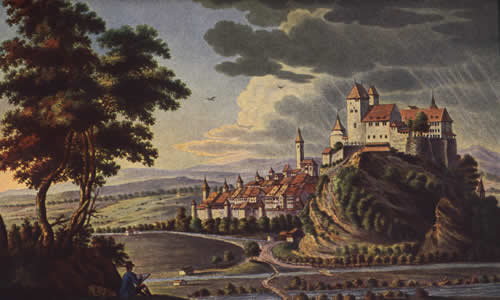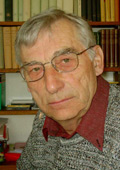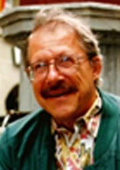Burgdorf and Münchenbuchsee
1799 – 1804/05
When Pestalozzi looked from the Gurnigelbad over the Swiss midlands he thought "One can see more of the ill- educated people from this view than the beauty of the sight" (PSW 13, pg. 191) which showed his dismay at the desolate condition of most of the village schools. He writes in "Wie Gertrud ihre Kinder lehrt" (How Gertrud teaches her children):
"These schools are essentially nothing else but artificial machines that suffocate all the power and experience which nature has brought to them [the children]. […] But just for a short moment imagine again the horror of this murder. One allows the children the complete pleasure of nature until the fifth year; one lets them absorb every aspect of it, they feel its power, they have already developed a feeling for its character and its charms. Nature is being internalised, already taking them in a certain direction in life. And after five whole years when they are used to relishing in the bliss of the more sensual side of life, suddenly this is gone and nature disappears in-front of their eyes, tyrannically obstructing this gentle and charming freedom. They are thrown together like sheep, loads of them crowded in a smelly room; for hours, days, weeks, months and years. Here they are chained to the misery of boring and monotonous work and to a way of life that differs so greatly from their former one it drives them mad. […] Does the strike of the sword that cuts across the neck bringing the criminal from life to death, have more effect on his body than on the soul of the child who experiences a transition from the joy of the guidance of nature to the most wretched school life?" (PSW 13, pg. 198-199).
Pestalozzi’s views were so strong about education that – at the age of 53 –he made the momentous decision to make teaching his profession despite it being despised and badly paid. The Helvetic educational minister Stapfer preferred to give Pestalozzi a position leading a newly-erected institution for the education of teachers as the state lacked one. But Pestalozzi’s primary interest was to gain experiences with the children. Stapfer then appointed his secretary Rudolf Fischer as director of teacher education and assigned him to work at Burgdorf castle thereby giving Pestalozzi the possibility to teach at Burgdorf. However as a precaution, for the time being the town authorities only let him teach at the so- called Hintersassenschule, where school classes already existed where he was assigned a corner for his experiments. Pestalozzi gave all his energy into finding a method to teach the pupils in a natural, more spiritual way. He put away all school- books and let the children experience their physical surroundings with all their senses. Learning, he believed, is predominantly about thinking first, then reading. After eight months his pupils took an examination and the success rate was so high that he was entrusted with one of the higher boys school in town.
In the meantime Fischer opened his institution but had become very ill and died soon after (4th of May, 1800). Pestalozzi then joined his boys’ class with the school founded by Fischer at the castle and thus laid the foundations of his educational institute in Burgdorf. It became the combination of a school for boys, a school for the poor, a boarding school for pupils living out of town, and a forum for teachers. The teaching of the powers of head, hand and heart, he believed, should be embedded in a community and developed harmonically. Pestalozzi soon had a line of people including the Helvetic government who supported and aspired to his beliefs. Very soon pupils were flocking to the scene.
With the help of his collaegues, Pestalozzi intensively worked on developing his new method of teaching. He wanted to publicise his new discoveries in the pedagogical sector as soon as possible. He started to do this in several smaller works, but mainly in his basic work "Wie Gertrud ihre Kinder lehrt". Pestalozzi, had already become well known in Europe 20 years ago for his novel "Lienhard und Gertrud" (Lienhard and Gertrud) and through his new work he was now becoming popular as a great educator and innovator of primary education. Hundreds of learned men and politicians from all over the world came to see Pestalozzi and his colleagues at work and to marvel at the results of the teaching. Burgdorf had become, like Yverdon did later, a compulsory station of the educational journeys to Switzerland and Italy which were now fashionable.
On August 15th in 1801 Pestalozzi's only son died at the age of 31. His wife moved in with Pestalozzi and one year later they both moved to Burgdorf together. The year of 1803 became one of the happiest years of Pestalozzi’s life. However, it was overshadowed by the political events: In the summer of 1802 Napoleon withdrew his troops from Switzerland, whereupon the civil war immediately flared up again. During this time, the Helvetic centralised state broke down. Shortly after the French troops returned, Napoleon ordered an assembly of delegates to Paris in order to work out a new constitution in the city. Pestalozzi was transferred to Paris both by his home- town institution in Zurich and by the town of Burgdorf. He stayed in Paris during the winter of 1802/03, but travelled back early and therefore did not partcipate in the solemn closing reception on February 19th in 1803 in the Tuileries and missed his only opportunity to meet Napoleon in person. Pestalozzi was opposed to some of his regimes, in particular, the imminent reintroduction of the tithe and the census, the right to vote and expressed his views in several pamphlets. He demanded a fairer tax burden and encouraged the development of the common education of the people Anmerkung. Unfortunately the so -called Mediation Constitution of 1803 never received the pamplets with Pestalozzi‘s views and proceeded to develop the Helvetic centralized state back into a federation, to a great extent, independent of the soveriegn state. The constitution of the soveriegn state in Zurich, spoke of political freedom and equality of the citizens, but because of the tithe and census being restored the "Ancien Régime" now applied only to the wealthy upper classes.
For Pestalozzi the new constitution had significant implications as there was no longer a central government on which he could have counted. In addition to this the government of Bern demanded him to leave Burgdorf castle with his institute until May 1st in 1804 in order for the new chief Bailiff of Bern to set up his residence there. In the meantime Pestalozzi and his institute found shelter in a decayed monastery in Münchenbuchsee close to the model estate and educational institute of Philipp Emanuel von Fellenberg . Without a doubt this aristocrat from Bern had great organisational and economic skills, two traits Pestalozzi positively lacked. Pestalozzi's collagues began to develop the connection of the two institutes: Fellenberg should organize and Pestalozzi should intersperse the whole operation with his ideas. However it wasn‘t long before the two fell out, as Fellenberg couldn‘t tolerate Pestalozzi admitting pupils from poor families into their institute free of charge. So again Pestalozzi found himself looking around for a place to make a new start. And so the castle in Yverdon (german: Iferten) in the newly founded area of Canton Waadt (Vaud), which was assigned to the town of Bern before the revolution,was now at the disposal of Pestalozzi and became the place where the life history of his educational institute began.


